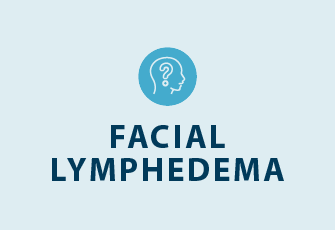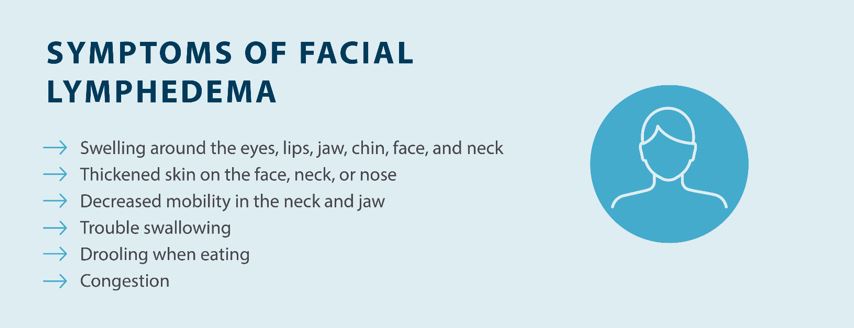Facial Lymphedema


Facial Lymphedema: Complete Guide
Lymphedema is a medical condition that’s caused by the improper function of the lymphatic system, resulting in swelling. When the lymphatic system can’t maintain proper fluid levels in your body, fluid from the lymphatic system may build up in the tissue. While lymphedema is most common in the legs and feet, facial lymphedema can occur, as well as lymphedema in other parts of the body, such as the abdomen or genitals. If you’re experiencing swelling around your face, you may be experiencing lymphedema in the face. In this guide below, we’ll cover all you need to know about facial lymphedema, from symptoms to causes and treatment.
What is Facial Lymphedema?
What Are the Symptoms of Facial Lymphedema?
What Causes Facial Lymphedema?
How Do You Treat Facial Lymphedema?
Can Facial Lymphedema Be Prevented?
Wrapping Up: Facial Lymphedema
What is Facial Lymphedema?
Facial lymphedema is a type of lymphedema that occurs in the head and neck rather than the lower body. This swelling may lead to numerous symptoms, including difficulty swallowing, a lack of mobility, and discomfort in the head and neck area. While facial lymphedema isn’t generally considered a medical emergency, you should visit a doctor or specialist as early as possible to get started on a treatment plan to prevent its progression.
Due to the areas lymphedema in the face typically affects, head and neck lymphedema treatment is ideal for facial swelling. While you can’t prevent lymphedema, there are steps you can take to reduce swelling and improve your quality of life. With regular treatment, including compression therapy, manual lymphatic drainage, and exercise, facial lymphedema can become significantly more manageable.
What Are the Symptoms of Facial Lymphedema?
Swelling is the most common symptom associated with lymphedema. While swelling is prevalent with facial lymphedema, different patients may also experience various symptoms, and knowing the signs can help you identify this condition and get relief from facial lymphedema. Here are some of the symptoms you should keep an eye out for if you think you may have facial lymphedema:1

- Swelling: Swelling is common around the eyes, lips, jaw, chin, face, and neck in people with facial lymphedema. This swelling may also lead to some of the other symptoms on our list, including decreased range of motion, mobility, and difficulty swallowing. You may have facial lymphedema if you’re experiencing swelling in the head and neck area, especially after cancer surgery or radiation therapy.
- Thickened skin on the face: The build-up of fluid that lymphedema causes can change the composition of your skin, resulting in a hardened, thickened feeling instead of its usual soft feel. This skin may become very thick and callused if you don’t take steps to manage the swelling caused by lymphedema.
- Decreased mobility in the neck and jaw: Swelling in the head and neck area can also make it difficult to move that part of your body freely. If your head and neck swelling is due to facial lymphedema, you might experience difficulty turning your head or looking up and down. Swelling can also make it hard to chew or open your mouth wide, which can make simple daily tasks more challenging.
- Trouble swallowing: If the swelling from facial lymphedema affects the neck, it may begin to put pressure on your throat and esophagus. Increased swelling in the throat and neck can make it hard to swallow food and drink liquids. Decongestive therapy can help you relieve some of the swelling that makes it difficult to swallow so you can continue to eat healthily and maintain your quality of life.
- Drooling when eating: Some people who have facial lymphedema can experience drooling while eating. Lymphedema’s facial effects can lead to decreased mobility and trouble swallowing, which may make drooling more prevalent.
- Congestion: The neck, face, and head are filled with small air pockets that connect to the nasal passages through small tubes. These are the sinuses, and your sinuses have a major effect on your nasal passages. Pressure on the sinuses can lead to congestion, making it difficult to breathe and blow your nose. Patients living with facial lymphedema may experience a constant feeling of having a cold or allergies due to congestion.
What Causes Facial Lymphedema?
Understanding the causes of lymphedema can help you understand the risk factors that can lead to facial lymphedema. While there are no preventative measures you can take to avoid lymphedema, secondary lymphedema, which is lymphedema that occurs because of trauma or surgery, can be discussed with your doctor should you need surgery or cancer treatment. Explore some of the top causes of facial lymphedema below:

- Cancer or cancer treatment: In some cases, patients can develop lymphedema as a result of cancer treatment. Cancer alone can cause damage to the lymphatic system if it spreads to the lymph nodes, and sometimes, the presence of cancer cells (tumor) may impact the lymphatic system and cause lymphedema even before cancer treatment. This also means that you may have lymph nodes removed or biopsies of lymph nodes taken to test for the spread of cancer.
- Lymph node removal: Lymph nodes are one of the most important parts of your lymphatic system, helping to filter bacteria and waste traveling through the system. If you have a lymph node removed to test for cancer or get rid of cancer in that area of your body, your lymphatic system may suffer as a result and lead to facial lymphedema.
- Radiation therapy: Radiation therapy can be extremely hard on your body, and your lymphatic system is no exception. Radiation therapy can lead to the development of scar tissue that can create a blockage in your lymphatic system, which impedes the flow of fluid, resulting in swelling. Your oncologist may discuss this with you when you’re considering radiation therapy as a treatment option.
- Surgery: Certain types of surgery — especially surgery that targets the lymphatic system — can lead to facial lymphedema. If a lymph vessel or node is damaged or removed during surgery, your lymphatic system may not be able to maintain proper fluid levels in the body. Again, this is something your doctor or surgeon should discuss with you if you’re considering getting surgery that may lead to facial lymphedema.
How Do You Treat Facial Lymphedema?
While there is no medication or surgery that gets rid of facial lymphedema, you do have options when it comes to facial lymphedema management. The main goals when treating facial lymphedema include reducing swelling, preventing the condition’s progression, and reducing potential complications.
Manual lymphatic drainage is a great place to start managing the symptoms of facial lymphedema.2 To perform a lymphatic massage, use your fingers to gently massage your face and neck to encourage the flow of fluid and relieve swelling. Your lymphedema specialist, physical therapist, or occupational therapist can show you the proper techniques to perform a manual lymphatic drainage massage on yourself at home.
Exercise is an essential part of relieving swelling and other symptoms of lymphedema.2 Regular exercise helps encourage the flow of fluid throughout your lymphatic system and helps you maintain a healthy weight, which can be a risk factor for lymphedema.
Proper skin care is also important for facial lymphedema patients, as bacteria can cause infections that can worsen lymphedema in the face. To take care of your skin, always wear sunscreen when going outdoors, treat any cuts by cleaning them with antiseptic soap, use caution when shaving, and avoid restrictive clothing around your neck.2
Compression therapy is another great tool for managing facial lymphedema at home. You can find compression devices like Tactile Medical’s Flexitouch Plus System, which is designed to treat the head and neck and provide targeted relief from swelling. Tactile Medical’s head and neck lymphedema treatment stimulates the lymphatic system to help patients manage their symptoms from the comfort of their homes to regain their quality of life.
Can Facial Lymphedema Be Prevented?
You may be wondering how to prevent lymphedema and the symptoms that come along with it. While there is no way to prevent facial lymphedema, there are steps patients can take to prevent its progression. By educating yourself on the causes and symptoms, you can identify signs of lymphedema and consult with your doctor.
If diagnosed, you and your doctor, specialist, or therapist can create a treatment plan to reduce swelling and prevent symptoms from progressing. With compression therapy, regular exercise, and manual lymphatic drainage massages, you can reduce swelling and avoid the complications that some facial lymphedema patients experience. If you haven’t already, you should talk to your doctor or specialist about facial lymphedema treatment options and what you can do to improve your quality of life.
Wrapping Up: Facial Lymphedema
Living with facial lymphedema can be difficult, especially when you don’t know how to effectively manage swelling that’s impacting your breathing and face. Fortunately, there are treatment options that can help you live a better life despite the symptoms you’re experiencing.
With the Flexitouch Plus System from Tactile Medical, you can get relief from swelling caused by lymphedema right at home. Gentle compression helps encourage the flow of fluid to reduce swelling, and the device is available not only for the head and neck but for the upper body and lower body, too. If you’re having a hard time finding relief from facial lymphedema, try the Flexitouch Plus System for head and neck treatment today.
Sources:
1. Miller, Matthew. Lymphedema. American Head and Neck Society. Accessed August 24, 2022. https://www.ahns.info/survivorship_intro/topical_review-lymphedema/
2. National Health Service. Head and Neck Lymphoedema. https://www.hey.nhs.uk/patient-leaflet/head-neck-lymphoedema/